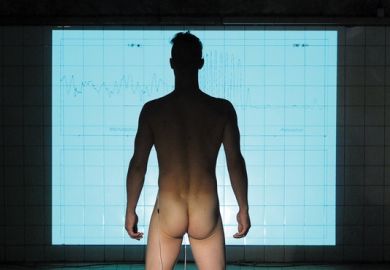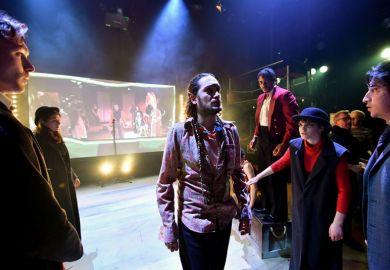Many people feel nostalgic for the kind of no-holds-barred anarchic creativity, often fuelled by lots of sex and drugs, said to have characterised art colleges in the 1960s.
But what does it mean to “teach a radical arts practice” in today’s very different educational environment? That was a question up for debate in a panel discussion at London’s Victoria and Albert Museum on 26 April. Among the speakers was Dominic Johnson, reader in performance and visual culture at Queen Mary University of London, where he teaches the theoretical element of the MA in live art.
There was indeed a moment in the late 1960s, he told Times Higher Education in advance of the discussion, characterised by “a certain freewheeling reckless activity that could, in certain instances and for certain students, lead to incredible and unique revelations that then take hold in their practice” – although others dismissed it as “absolute garbage”. A number of factors made such a model far less realistic today.
Much art education, Dr Johnson noted, now takes place not in independent institutions but within “large organisations that are less heterogeneous across different departments”. Students paying substantial tuition fees have much clearer “expectations about specific kinds of return”, and that “inhibits the freedom to mess around for a few years until you find yourself”. Programmes are “very assessment-driven and often modular”, so students cannot afford to “experiment and get things wrong” because any “mistakes” appear on their transcripts and can be brought up in job interviews. Students also tended to have internalised the idea of clear learning objectives, which meant that “a model of experimentation where people would go out into the wilderness and fend for themselves and then come back and make something is not really tenable any more”.
While he broadly welcomed the introduction of more rigour and accountability (if not higher fees), Dr Johnson admitted that such developments restricted “radical, anarchic teaching and learning methods”. His 2015 book on performance art and artists, The Art of Living, features one artist who “slathers her husband in food, and feeds him through a tube, after secreting him in bondage in the darkest basement of her love”. Is there any way that universities can support students who want to pursue this kind of strange and disturbing work?
Although “it’s not about anything goes”, Dr Johnson said that he sought “to create an environment where experiment and managed risk are part and parcel of making work”.
“It would be a kind of pedagogical hypocrisy”, Dr Johnson pointed out, “to show students work that you then wouldn’t allow them to find safe and reasonable ways of exploring in practice…I get frequent emails from students from all over the country who want to make a show where they insert a needle into their skin or make an incision with a scalpel – something not particularly anomalous within the history of live art – but will be absolutely prevented from doing so by tutors or technical teams.”
Many of these issues could be managed using risk assessments, said Dr Johnson, and by asking: “Are they really more risky than other things common in the theatre, or is there just a moral objection?” He remained keen to “allow students to think about practices that have questionable legitimacy because they are against the market, ephemeral, resistant to legibility or can’t be housed in institutions. Those sorts of things trouble the way institutions function. Live art tends to emphasise those resistant aspects of what art can do.”
POSTSCRIPT:
Print headline: Anarchy allowed: finding space for performance art that unsettles
Register to continue
Why register?
- Registration is free and only takes a moment
- Once registered, you can read 3 articles a month
- Sign up for our newsletter
Subscribe
Or subscribe for unlimited access to:
- Unlimited access to news, views, insights & reviews
- Digital editions
- Digital access to THE’s university and college rankings analysis
Already registered or a current subscriber?








